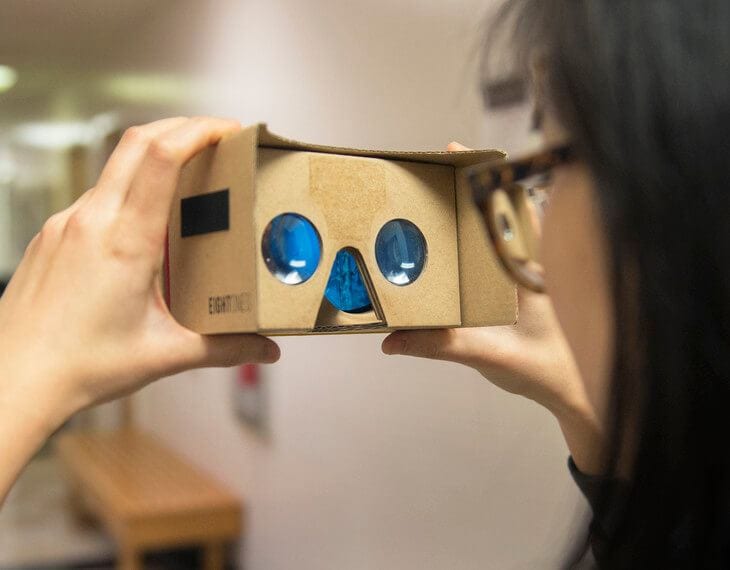GEOG 397 convenes for the first time at University Park in Fall 2018
University Park, Pa. –In his decade of teaching at Penn State, geography professor Alex Klippel has seen immersive technologies disrupt everything at the University from education to research to outreach. His belief in the power of this machinery to improve the learning process guided his creation of GEOG 397: Immersive Technologies – Transforming Society through Digital Innovation.
“I created one of the first upper-level courses on [Virtual Reality] and 3D modeling and I want to share my fascination for immersive technologies with students at all levels,” Klippel said of the brand-new general education course he created alongside instructional designer Amy Kuntz. “Thanks to generous support and marvelous collaboration [with the Teaching and Learning with Technology department] we are able to advance immersive learning at Penn State and share it with a wider audience.”
Klippel and Kuntz have crafted a course designed to attract a broad range of disciplines from earth sciences to education to architecture to engineering and beyond. Adding to GEOG 397’s extensive appeal is its lack of prerequisites. Through the course’s lectures and labs, students will experience creating their own immersive experiences, designing 3D models, capturing 360°images, and learning the theories behind immersion, presence, and realism.
Technology’s rapid evolution, and the lowering entry points to immersive equipment, make the professional landscape for college graduates an ambiguous one. Studies show that a significant number of jobs in the coming decades don’t currently exist. Klippel’s aim for his new course is to appeal to a broad range of students and give them an entry point to knowledge powerful enough to alter everyday life.
“[At the end of the course] students will have an overview of all the different ways immersive experiences are changing our lives; from analyzing crime scenes to training surgeons to virtually touring the world,” Klippel noted.
Research dating back to 2006 shows job trainees retain knowledge better through virtual reality as opposed to traditional video. That evidence has contributed to oil rigs training workers in VR since 2014, healthcare providers using the technology to instruct physicians on complex procedures, Walmart rolling out a VR program to all 200 of its training academies, and Volvo offering test drives in virtual reality.
Kuntz, who led the effort in designing how GEOG 397 would function as a new course, added, “I would really like for students to see the applicability of immersive technologies for their own personal interests and career paths. They can be used as a tool to prepare for conducting a sales pitch to a client or exploring something not on a human scale such as navigating blood vessels inside the human body at a microscopic level.”
Because GEOG 397 is novel and not many students have experienced immersive technology first-hand, Kuntz says the course’s early aim will be on providing a foundation of the core concepts and various implications of immersive experiences.
“To overcome this challenge, in addition to focusing on addressing concerns during class, there will be a wealth of online educational material including instructional videos,” Kuntz noted. “There will also be a stepped approach of assignments that will lead to creating an online portfolio showcasing student-generated 3D models and immersive experiences.”
Although they may not be aware of it, 77 percent of Americans carry in their pocket an entry point to their own immersive experiences. Recent Pew Center research shows that over three quarters of the country owns a smartphone, and when paired with a viewing headset – widely available for less than $10 – those devices open the world of 360° video. Google alone has already shipped more than 10 million of its Google Cardboard headsets. Those numbers only partially illustrate how much immersive technology is beginning to impact society. How, then, could Klippel’s students be prepared to enter a workforce tasked with staying ahead of the pace of change? It was not a question that went ignored as the course was designed.
“We want [the course] to be relevant with the most up-to-date information, and the way the technology is increasing made us think about how much of the course to spend on a particular area opposed to another,” said Kuntz. “To accommodate some flexibility, the last portion of the course will be dedicated to future topics to account for new, exciting developments.”
A likely future topic for GEOG 397 to touch on in Fall 2018 will be augmented reality. The technology that enhances real-world environments with computer-generated sensory information leapt into the national conscience in the summer of 2016 when Pokémon Go was unveiled. Since then development of augmented reality apps has increased, but high price points and limited access have limited consumer adoption. Ever the forward thinker, though, Klippel knows augmented reality’s evolution will impact his new course.
“We have put in the paperwork to make GEOG 397 a permanent course. That means we have a lot of work ahead to keep pace with technology’s rapid development. With augmented reality, as an example, I see it progressing quickly and becoming a more central topic,” he said. “So, the bottom line is that this is a dynamic course that will be at the pulse of immersive technologies as they evolve.”
Interested University Park students can get in at the ground level of this cutting-edge course because space remains available for enrollment in the inaugural offering. Klippel, their instructor, has extensive experience with innovative immersive experience technologies. Among his prior projects was joining a team that created a 3D model of the interior of the dormant Thrinukagigur volcano in Iceland.
“I want to share my enthusiasm for immersive technology and I envision that students will be excited about its potential across different disciplines,” he said. “Everyone is able to create immersive experiences and we’ll teach the students how.”
